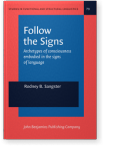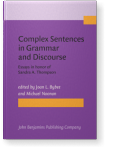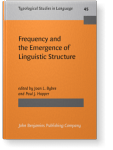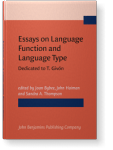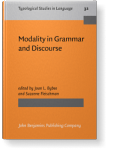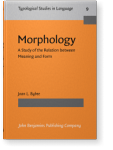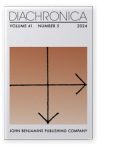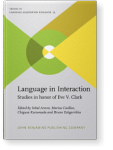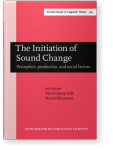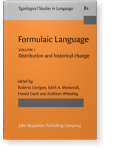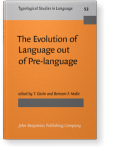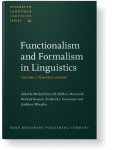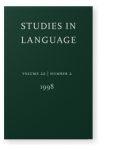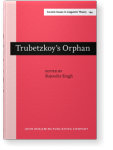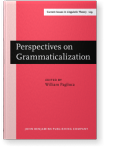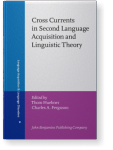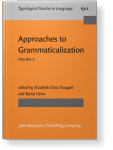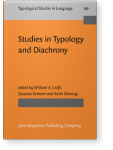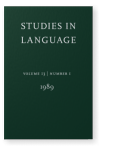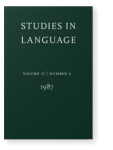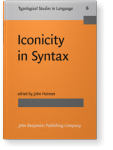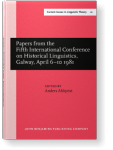Joan L. Bybee
List of John Benjamins publications for which Joan L. Bybee plays a role.
Book series
Complex Sentences in Grammar and Discourse: Essays in honor of Sandra A. Thompson
Edited by Joan L. Bybee and Michael Noonan
[Not in series, 110] 2002. viii, 363 pp.
Subjects Discourse studies | Pragmatics | Syntax | Theoretical linguistics
Frequency and the Emergence of Linguistic Structure
Edited by Joan L. Bybee and Paul J. Hopper
[Typological Studies in Language, 45] 2001. vii, 492 pp.
Subjects Historical linguistics | Psycholinguistics | Typology
Essays on Language Function and Language Type: Dedicated to T. Givón
Edited by Joan L. Bybee, John Haiman and Sandra A. Thompson
[Not in series, 82] 1997. vi, 480 pp.
Subjects Functional linguistics | Theoretical linguistics | Typology
Modality in Grammar and Discourse
Edited by Joan L. Bybee and Suzanne Fleischman
[Typological Studies in Language, 32] 1995. viii, 575 pp.
Subjects Discourse studies | Functional linguistics | Historical linguistics | Pragmatics | Syntax | Typology
Morphology: A Study of the Relation between Meaning and Form
Joan L. Bybee
[Typological Studies in Language, 9] 1985. xii, 235 pp.
Subjects Morphology | Theoretical linguistics | Typology
2024 Diachrony and Diachronica: 40@40 Diachronica 41:5, pp. 719–731 | Editorial
2014 Analytic and holistic processing
in the development of constructions Language in Interaction: Studies in honor of Eve V. Clark, Arnon, Inbal, Marisa Casillas, Chigusa Kurumada and Bruno Estigarribia (eds.), pp. 303–314 | Article
A corpus analysis over several decades of American English shows the development of the minor construction from an idiom: not have two Xs to rub together. The sequence of developments indicates that the loss of compositionality and analyzability of the construction is heavily influenced by context… read more
2012 Patterns of lexical diffusion and articulatory motivation for sound change The Initiation of Sound Change: Perception, production, and social factors, Solé, Maria-Josep and Daniel Recasens (eds.), pp. 211–234 | Article
Patterns of lexical diffusion can serve as important diagnostics for the source of sound change. The most common lexical diffusion pattern for sound change is from high frequency words to low frequency words. This pattern is consistent with an articulatory source for change, as compared to a… read more
2009 The role of prefabs in grammaticization: How the particular and the general interact in language change Formulaic Language: Volume 1. Distribution and historical change, Corrigan, Roberta, Edith A. Moravcsik, Hamid Ouali and Kathleen Wheatley (eds.), pp. 187–218 | Chapter
Studies of grammaticization often reveal skewed distributions of lexical items in grammaticizing constructions, suggesting the presence of prefabs using these constructions. We examine here the role of prefabs in the grammaticization of can in English and the progressive estar ‘be (located)’ +… read more
2002 Main clauses are innovative, subordinate clauses are conservative: Consequences for the nature of constructions Complex Sentences in Grammar and Discourse: Essays in honor of Sandra A. Thompson, Bybee, Joan L. and Michael Noonan (eds.), pp. 1–17 | Article
2002 4. Sequentiality as the basis of constituent structure The Evolution of Language out of Pre-language, Givón, T. and Bertram F. Malle (eds.), pp. 109–134 | Chapter
2002 Introduction Complex Sentences in Grammar and Discourse: Essays in honor of Sandra A. Thompson, Bybee, Joan L. and Michael Noonan (eds.), pp. vii–viii | Miscellaneous
2001 Frequency effects on French liaison Frequency and the Emergence of Linguistic Structure, Bybee, Joan L. and Paul J. Hopper (eds.), pp. 337–360 | Article
2001 Introduction to frequency and the emergence of linguistic structure Frequency and the Emergence of Linguistic Structure, Bybee, Joan L. and Paul J. Hopper (eds.), pp. 1–24 | Article
1999 Usage-based Phonology [Functionalist phonology position paper] Functionalism and Formalism in Linguistics: Volume I: General papers, Darnell, Michael, Edith A. Moravcsik, Michael Noonan, Frederick J. Newmeyer and Kathleen Wheatley (eds.), pp. 211–242 | Article
1998 A Functionalist Approach to Grammar and Its Evolution Evolution of Communication 2:2, pp. 249–278 | Article
1998 Prosody and Segmental Effect Some Paths of Evolution for Word Stress Studies in Language 22:2, pp. 267–314 | Article
This study reports on a significant negative association found in a cross-linguistic sample between the degree of predictability of word stress from a word boundary and the extent to which stress has segmental effects. In other words, in a given language the less predictable stress is from the… read more
1997 Semantic Aspects of Morphological Typology Essays on Language Function and Language Type: Dedicated to T. Givón, Bybee, Joan L., John Haiman and Sandra A. Thompson (eds.), pp. 25–38 | Article
1996 Productivity, Regularity and Fusion: How language use affects the lexicon Trubetzkoy's Orphan: Proceedings of the Montréal Roundtable on “Morphonology: contemporary responses” (Montréal, October 1994), Singh, Rajendra (ed.), pp. 247–269 | Article
1996 A Reply to Goad Trubetzkoy's Orphan: Proceedings of the Montréal Roundtable on “Morphonology: contemporary responses” (Montréal, October 1994), Singh, Rajendra (ed.), pp. 280–283 | Article
1995 The Semantic Development of Past Tense Modals in English Modality in Grammar and Discourse, Bybee, Joan L. and Suzanne Fleischman (eds.), pp. 503–518 | Article
1994 Asymmetries in tense and aspect systems Perspectives on Grammaticalization, Pagliuca, William (ed.), pp. 235–254 | Article
1991 Natural morphology: the organization of paradigms and language acquisition Cross Currents in Second Language Acquisition and Linguistic Theory, Huebner, Thom and Charles A. Ferguson (eds.), pp. 67–92 | Article
1991 Back to the future Approaches to Grammaticalization: Volume II. Types of grammatical markers, Traugott, Elizabeth Closs and Bernd Heine (eds.), pp. 17–58 | Article
1990 On the asymmetries in the affixation of grammatical material Studies in Typology and Diachrony: Papers presented to Joseph H. Greenberg on his 75th birthday, Croft, William A., Suzanne Kemmer and Keith Denning (eds.), pp. 1–42 | Article
1989 The Creation of Tense and Aspect Systems in the Languages of the World Studies in Language 13:1, pp. 51–103 | Article
1987 Review of Dahl (1985): Tense and Aspect Systems Studies in Language 11:2, pp. 447–458 | Review
1987 The evolution of future meaning Papers from the 7th International Conference on Historical Linguistics, Giacalone Ramat, Anna, Onofrio Carruba and Giuliano Bernini (eds.), pp. 109–122 | Article
1985 Diagrammatic iconicity in stem-inflection relations Iconicity in Syntax: Proceedings of a symposium on iconicity in syntax, Stanford, June 24–26, 1983, Haiman, John (ed.), pp. 11–48 | Article
1982 Why small children cannot change language on their own: suggestions from the English past tense Papers from the Fifth International Conference on Historical Linguistics, Galway, April 6–10 1981, Ahlqvist, Anders (ed.), pp. 29–37 | Article
